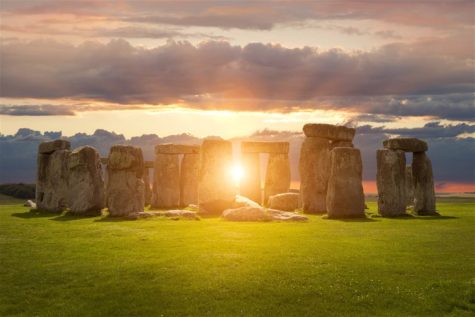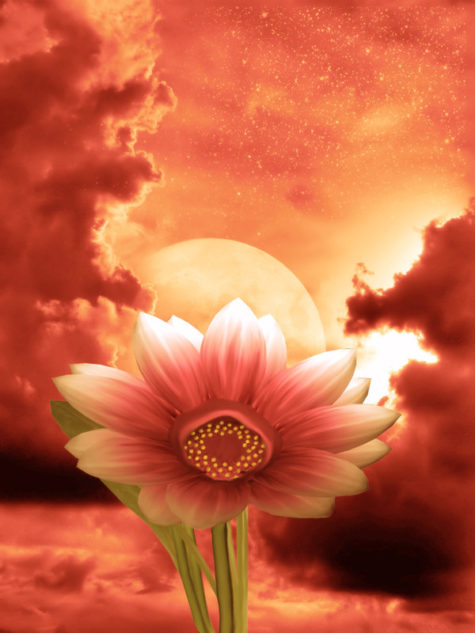June Skies
Cancer is the fourth sign of the zodiac. The sun enters Cancer at slightly different times each year, usually around June 22, sometimes the day before or the day after.
- Symbol: The Crab
- Element: Water
- Gemstone: Ruby
- Keyword: I Feel
Cancer is ruled by the moon, which emphasizes the sensitive, emotional side of our natures. Cancers love the security of home and family, and enjoy the responsibility of parenthood. They enjoy buying things for their homes, and many of them build up collections of objects that appeal to them. Cancerians are loyal friends and are always willing to provide a shoulder to lean on when others need it. Cancerians are highly intuitive, and can sum people up at a glance.
From 365 Goddess, we have this for today:
- Themes: Kinship; Protection; Kindness; Moon; Love; Devotion; Fertility; Relationships
- Symbols: Fish; Moon; Silver (lunar), Blue Items (her favorite color); Crab
- Presiding Goddess: Lady of Regla
About the Lady of Regla:
This West Indian fish mother swims in with summer rains as the bearer of fertility, family unity, prospective life mates, and other traditionally lunar energies. Shown in art looking much like a mermaid, the Lady of Regla is also the patroness of this astrological sign.
To Do Today:
In astrology, those born under the sign of Cancer have a great deal of compassion, desire family closeness and stability, and are ruled by the moon, all of which characterize this goddess’s energies to a tee. How you emphasize those powers depends on what you need. For harmony at home, add blue highlights to your decorating scheme, and wear pale blue clothing when having difficult conversations.
Eat fish or crab today to digest a little extra self-love or empathy, or to encourage fertility in any area of your life. To spice up this magic, serve the fish with a bit of lemon juice – a fruit that emphasizes devotion and kinship.
If you’d like to dream of future loves or get the Lady of Regla’s perspective on a difficult family situation, leave her an offering of yams before going to bed. According to local custom, this invokes Regla’s favor and you will experience helpful night visions – so take notes!
More About the Sun in Cancer:
The Sun is in Cancer from June 21 to July 21, depending on the year.
- Ruler: the Moon
- Modality: Cardinal
- Season: Summer
- Metal: Silver
- Stone: Pearl, Opal
- Color: White, Yellow
- Flower: Moon Flower, Rhododendron
- Anatomy: Breasts, stomach
- Attributes: gentle, conservative, feeling, nurturing, defensive, contemplative.
Sun in Cancer natives have a strong survival instinct. They are protective of those they care about, and of themselves too. They are often quite reticent about sharing their inner selves to the rest of the world, and are often caught up in reminisce.
Cancers have a reputation for moodiness, although this trait is most evident when the Moon is in Cancer. Cancer needs roots. They resist change to an extent, and concern themselves about being secure and safe in most everything they do.
Cancers can be quite intrigued by objects with history attached to them — antiques, photos, souvenirs, and the like.
Cancer is a very sensitive sign, and they don’t always appreciate it when you are blunt with them. Their reactions to hurt will depend on how thick a shell they have developed. Most Cancers react by withdrawing or retreating. Some have developed an ability to manipulate others to get what they want. They avoid direct confrontations almost as a rule.
Cancers are, in fact, quite yielding and soft when you have them in the right mood. They are one of the more hospitable signs of the zodiac. Sure, they can be touchy and indirect, but they are also very dependable, caring souls.
Source: Cafe Astrology
“Solstice” is derived from two Latin words: “sol” meaning sun, and “sistere,” to cause to stand still. This is because, as the summer solstice approaches, the noonday sun rises higher and higher in the sky on each successive day. On the day of the solstice, it rises an imperceptible amount, compared to the day before. In this sense, it “stands still.”
(In the southern hemisphere, the summer solstice is celebrated in December, also when the night time is at a minimum and the daytime is at a maximum.)
Why does the summer solstice happen?
On this day, typically June 21, the daytime hours are at a maximum in the Northern hemisphere, and night time is at a minimum. It is officially the first day of summer. It is also referred to as Midsummer because it is roughly the middle of the growing season throughout much of Europe.
The seasons of the year are caused by the 23.5° tilt of the earth’s axis. Because the earth is rotating like a top or gyroscope, the North Pole points in a fixed direction continuously — towards a point in space near the North Star. But the earth is also revolving around the sun. During half of the year, the southern hemisphere is more exposed to the sun than is the northern hemisphere. During the rest of the year, the reverse is true.
At noontime in the Northern Hemisphere the sun appears high in the sky during summertime, and low during winter. The time of the year when the sun reaches its maximum elevation occurs on the summer solstice — the day with the greatest number of daylight hours. It typically occurs on, or within a day or two of, June 21, the first day of summer. The lowest elevation occurs about Dec 21 and is the winter solstice — the first day of winter, when the night time hours reach their maximum.
Activities for the Summer Solstice:
- Rise early on the summer solstice and greet the sun as it begins to brighten the sky.
- Create protective amulets out of rue, rowan and basil. Place these herbs in a clean white or gold cloth, and tie the cloth securely.
- Make a protective charm for your home or business. Tie a few cinnamon sticks together and position them over the door of your home or office.
- Consume foods that honor the power of the sun. Include foods that are yellow and orange. Lemons are particularly good for this purpose and can be consumed in desserts as well as in tea or lemonade.
- Leave some food out for the fairy folk that are active at midsummer. Good choices include milk, wine, honey, water and fresh bread.
Information collected from various sources
What follows is a list (in alphabetical order) of the names given to the June moon. Also listed is the tradition and/or origin of that moon name:
- Aerra Litha Moon ~other
- Blackberry Moon ~Greek
- Buffalo Moon ~Omaha
- Corn Tassel Moon ~Taos
- Dark Green Leaves Moon ~Pueblo
- Dyad Moon ~Medieval English
- Fish Spoils Moon ~Wishram
- Flower Moon ~Cherokee
- Green Corn Moon ~Cherokee
- Green Grass Moon ~Sioux
- Hay Moon ~other
- Hoer Moon ~Abernaki
- Horses’ Moon ~Celtic
- Honey Moon ~Algonquin
- Hot Moon ~Algonquin
- Hot Weather Moon ~Ponca, Arapaho
- Leaf Moon ~Assiniboine
- Leaf Dark Moon ~San Juan
- Leaves Moon ~Cree
- Lotus Moon ~Chinese
- Lovers’ Moon ~other
- Major Planting Moon ~Hopi
- Making Fat Moon ~Lakota
- Mead Moon ~Janic (full)
- Planting Moon ~Neo Pagan
- Ripe Berries ~Dakota
- Ripening Moon ~Mohawk
- Rose Moon ~Algonquin
- Strawberry Moon ~Anishnaabe, Dark Janic, Algonquin
- Strong Sun Moon ~other
- Summer Moon ~Kiowa, Passamaquoddy
- Turtle Moon ~Potawatomi
- Water Melon Moon ~Natchez
- Windy Moon ~Choctaw
Good weather in “Flaming June” is necessary if there is to be a good harvest. Country weather lore states:
- If June with bright sun is blessed, for harvest, we will thank the Goddess.
- If June be sunny, harvest comes early.
- A cold and wet June ruins the rest of the year.
- It is said that if it rains on 27 June, then it will rain for the next seven weeks.
- A wet June makes a dry September.
- A dripping June brings all things in tune.
- If swallows fly near the ground in June, it is a sign of coming rain.
- Bats flying on a June evening are a sign of hot, dry weather the next day.
- A calm June puts the farmer in tune.
- June damp and warm, does the farmer no harm.
- Rain on St Vitus’ Day (June 15), brings rain for 30 days in a row.
According to country lore, it was also claimed that summer doesn’t actually begin until the elder is in flower.
Information collected from: various sources
The first (or only) full moon in June is called the Honey Moon. Tradition holds that this is the best time to harvest honey from the hives.
Correspondences:
- Colors: Sun colors — gold, yellow, orange
- Gemstones: Topaz, agate
- Trees: Oak, maple
- Gods: Isis, Cerridwen, Persephone
- Herbs: Parsley, mosses, skullcap, mugwort
- Element: Earth
This is the month where magical workings are well suited to maintaining and enhancing things you already have. Weed your garden, prune the bushes, give your lawn all the tender loving care it needs. Take time to let your personal life blossom as well – focus on things that improve your job or education, as well as your relationships with family and friends.
This time of year, between the planting and harvesting of the crops, was the traditional month for weddings. This is because many ancient peoples believed that the “grand [sexual] union” of the Goddess and God occurred in early May at Beltaine. Since it was unlucky to compete with the deities, many couples delayed their weddings until June.
June remains a favorite month for marriage today. In some traditions, newly wed couples were fed dishes and beverages that featured honey for the first month of their married life to encourage love and fertility. The surviving vestige of this tradition lives on in the name given to the holiday immediately after the ceremony: “The Honeymoon.”
In June, we’re beginning to see some early summer fruits and vegetables (a great time for strawberry crops!), and the days are getting longer and longer. It’s a far cry from the darkness of winter, and we typically try to spend as much time outside as possible. Also known as Lover’s Moon, Long Sun Moon, it’s a time for bonding with friends and family, and forging what connections we can. Nurture your relationships, your garden, your career, and your soul this month.
In pre-historic times, summer was a joyous time of the year for those Aboriginal people who lived in the northern latitudes. The snow had disappeared; the ground had thawed out; warm temperatures had returned; flowers were blooming; leaves had returned to the deciduous trees. Some herbs could be harvested, for medicinal and other uses. Food was easier to find. The crops had already been planted and would be harvested in the months to come.










